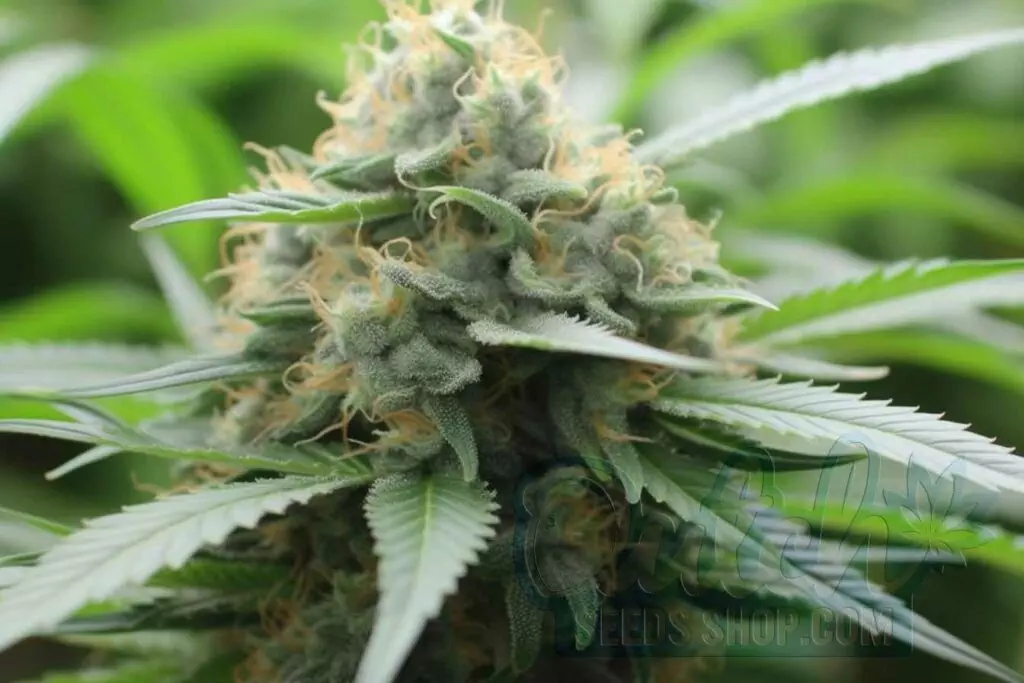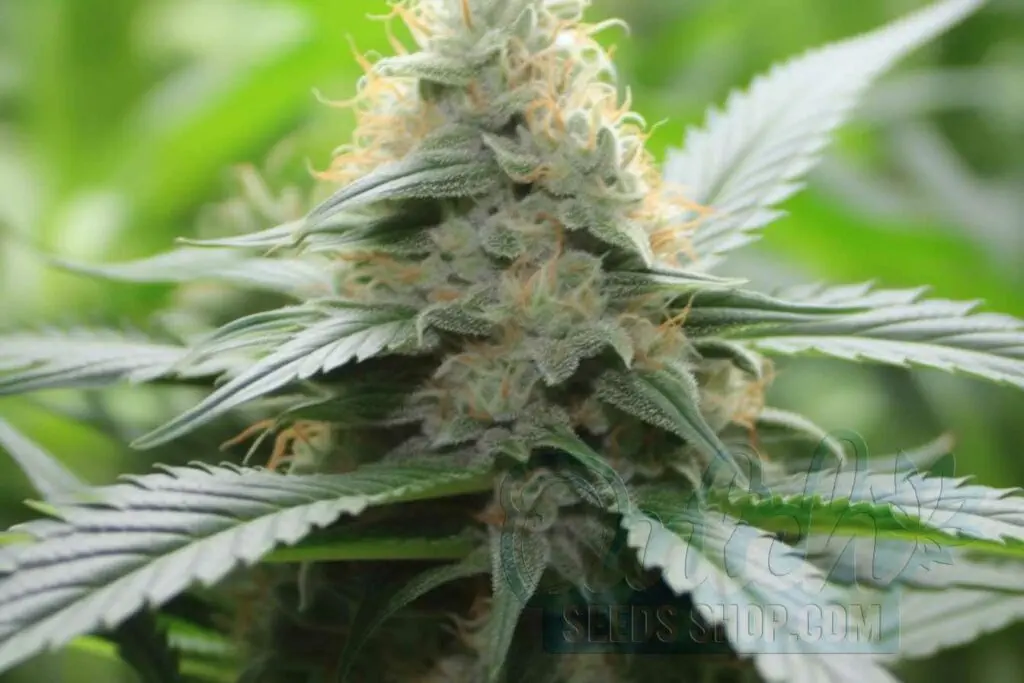Lamb’s Bread Marijuana Strain Information and Review
Venture into the vivid world of Lamb’s Bread Strain, a genuine gem in the cannabis constellation. This sativa-dominant superstar hails from the rhythmic heart of Jamaica, carrying the spirit of the island in every leaf and bud.

Type: 5% Indica / 95% Sativa
Genetic: Jamaican Sativa landrace
THC: 16 – 21%
CBD: 0.01 – 0.2%
Terpenes: Caryophyllene, Humulene, Limonene, Myrcene, Pinene, Terpinolene
Flowering Time: 63 – 70 days
Indoor Yield: 1.2 – 1.4 oz/ft²
Outdoor Yield: 12 – 15 oz/plant
Effects: Analgesic, Calming, Happy, Relaxed
Flavors/Taste: Citrus, Earthy, Herbal, Sweet
Often called the “green gold,” Lamb’s Bread is not merely a strain but an aromatic ambassador of peace and creativity, steeped in a cultural brew of music, freedom, and rebel spirit.
Its reputation as a source of inspiration and clarity is no urban legend – it’s the soul-food for artists and thinkers, a catalyst for change in a smokable form.
So, let’s light up the details and unfurl the green tapestry that is Lamb’s Bread Strain.
Key Takeaways:
- Lamb’s Bread is a sativa-dominant strain with uplifting and creative effects.
- It originates from Jamaica and has a rich history tied to Rastafarian culture.
- The strain features a distinct appearance with bright green buds and a high trichome count.
- Lamb’s Bread has a complex terpene profile that contributes to its earthy and piney aroma with hints of spice.
- THC levels range between 16-21%, with negligible CBD content.
- Common effects include increased energy, mental clarity, and motivation.
- Potential negative effects are minimal but can include dry mouth and eyes.
- It’s reported to be beneficial for managing stress, depression, and fatigue.
- Growing Lamb’s Bread requires attention to space, light, and climate, favoring a warm, tropical environment.
- It offers generous yields and has a flowering time of about 9 to 10 weeks.
- When compared to other strains, Lamb’s Bread stands out for its high yield and uplifting effects.
Lamb’s Bread Strain Strain Genetics
Lamb’s Bread Strain is a masterpiece of genetics, a strain that’s as much about its effects as it is about its rich lineage.
In the cannabis world, this strain is revered not just for its potent punch but also for the purity of its roots.
It’s a genetic treasure trove that offers a glimpse into the natural world of cannabis, untouched by the hand of commercial breeding.
Origins and Lineage
Tracing the roots of Lamb’s Bread takes us back to the lush landscapes and rolling hills of Jamaica – a place where cannabis is not just grown, but celebrated as a part of life.
Lamb’s Bread is believed to be a direct descendant of the original Jamaican sativa landraces, strains that have adapted over centuries to their natural environment, evolving a robust and vibrant genetic profile.
These landraces are the building blocks of many modern sativas, but Lamb’s Bread stands out for retaining its pure lineage, unadulterated by the waves of hybridization that have swept the cannabis world.
History
The history of Lamb’s Bread is steeped in Rastafarian culture, where it’s been smoked for meditation and as a vessel for spiritual journeying.
Its name is believed to be a nod to “lamb’s bread,” a term used in Rasta culture to refer to something that’s greatly beneficial or spiritually powerful.
Lamb’s Bread has been the muse for countless reggae artists, with some suggesting that Bob Marley himself was a fan of this transcendent strain.
Its legendary status is maintained by its rarity and the fondness with which it’s spoken of – an herb that symbolizes peace and the power of nature.
Appearance of Lamb’s Bread Strain Weed
Taking a closer look at Lamb’s Bread, one can’t help but be impressed by its striking presence.
It’s a physical manifestation of its vibrant sativa heritage, with buds that are dense and almost art-like in structure, coated in a sparkling layer of trichomes that resemble tiny diamonds.
Visual Characteristics:
- Colors: A tapestry of deep forest greens interwoven with brighter, almost neon, lime shades.
- Bud Structure: The buds are often elongated and fluffy, typical of sativa strains, with a loose leaf structure that fluffs up nicely when ground.
- Unique Characteristics: The crowning glory of Lamb’s Bread is the frosty layer of trichomes, so thick and shiny that the buds almost appear sugar-frosted. Amber pistils twist and curl among the trichomes, adding to the strain’s eye-catching allure.
Is Lamb’s Bread Strain Indica or Sativa?

Without a doubt, Lamb’s Bread is a proud representative of the sativa family.
With its sativa lineage shining bright at a whopping 95%, its mere 5% indica genetics do little to temper the quintessential sativa traits that Lamb’s Bread exhibits.
It’s the epitome of what a pure sativa strain aims to be – energizing, uplifting, and mentally stimulating, a clear departure from the sedative qualities associated with indicas.
Cannabinoids and Terpenes
Diving into Lamb’s Bread, one discovers a treasure trove of cannabinoids and terpenes, each component a thread in the tapestry of this strain’s profound effects.
The alchemy of Lamb’s Bread lies in its unique blend of these compounds, delivering a symphony of sensations and therapeutic benefits.
The cannabinoids set the stage for the experience, while the terpenes add depth and nuance, painting a full-bodied portrait of flavor and aroma.
Terpenes Profile
The terpene profile of Lamb’s Bread is a melodious composition that sings to the senses.
These aromatic compounds are the soul behind the scent and flavor, each playing its role in perfect harmony:
- Myrcene: Imparts earthy, musky notes, reminiscent of ripe tropical fruits mingling with the scent of the forest floor after rain.
- Caryophyllene: Offers a spicy kick, a zesty twist that tingles on the taste buds, bringing a peppery warmth to the mix.
- Pinene: Infuses the air with a sharp, refreshing burst of pine, cutting through the richness with a clean, uplifting aroma.
- Limonene: Completes the concert with a citrusy zing, lifting the spirits and cleansing the palate with its lemony zest.
THC and CBD levels
Lamb’s Bread is known for its high THC levels, which can range significantly depending on the grow conditions and the specific phenotype.
CBD levels are typically on the lower side, a common trait for strains with such strong sativa genetics.
| Cannabinoid | Percentage Range |
| THC | 16-21% |
| CBD | 0-1% |
Aroma and Flavor
The aroma of Lamb’s Bread hits the nose like a Jamaican breeze, rich with the promise of tropical forests and earthy goodness.
It’s a complex bouquet that wraps around you, warm and welcoming.
As for flavor, this strain dances on the tongue with a piquant spiciness softened by sweet herbal notes, leaving a lingering taste that’s as vibrant as the music of its homeland.
Lamb’s Bread Strain Strain Effects and Medical Benefits
The effects and medical benefits of Lamb’s Bread are the crowning jewels of this strain’s profile.
Beyond its sensory delights, it’s the profound impact on body and mind that has cemented Lamb’s Bread’s legendary status.
Feelings
Lamb’s Bread delivers an experience that is often described as a burst of energy and creativity.
It’s like a mental espresso shot:
- Euphoric: A soaring high that elevates mood.
- Uplifting: Banishes the blues and instills a sense of joy.
- Energetic: Fuels the body with a steady stream of vitality.
- Creative: Opens the floodgates of imagination and inspiration.
- Focused: Sharpens the mind for improved concentration.
Negatives
While Lamb’s Bread is a beacon of positivity, it comes with a cautionary note for potential negatives:
- Dry Mouth: Keep water handy; you’re going to need it.
- Dry Eyes: Those peepers might feel a tad scratchy.
- Paranoia: In higher doses, some may find their thoughts taking a sharp turn towards anxious.
- Dizziness: Especially for novice users, the intensity can be a bit much, so take it slow.
Lamb’s Bread Strain Strain Helps With
The therapeutic applications of Lamb’s Bread are well-recognized, particularly in the following areas:
- Stress: Acts as a balm for frayed nerves.
- Depression: Its uplifting nature is a natural antidote to the blues.
- Fatigue: Delivers a jolt of energy akin to a power nap.
- Pain: Offers relief by diverting the mind and soothing the body.
- Appetite Loss: Stimulates the munchies, making food more appealing.
Growing Lamb’s Bread Strain
Growing Lamb’s Bread strain is like composing a reggae tune; it’s an art that requires rhythm, patience, and respect for the grow.
This sativa-heavy hitter from the Jamaican heartlands is as rewarding as it is demanding, offering growers a chance to work with a piece of cannabis royalty.
Lamb’s Bread Strain Seeds

When it comes to Lamb’s Bread seeds, there’s a garden variety to choose from:
- Regular Seeds: A mix of male and female plants, ideal for breeders and those looking to pheno-hunt for that perfect expression.
- Feminized Seeds: All-female lineup, guaranteeing that flower power without the risk of pollination.
- Autoflowering Seeds: No need to switch up the light cycle; these genetics flip to flowering all on their own, a beginner-friendly option that’s fast and low maintenance.
Growing Guide
Lamb’s Bread doesn’t just grow; it performs, demanding a grower’s full engagement.
This strain flourishes under a steady hand, with its sativa genetics dictating a grow guide that’s all about maximizing light exposure and maintaining a tropical vibe in terms of temperature and humidity.
Indoor and Outdoor Growing Info
Indoors, Lamb’s Bread requires ample space to stretch its long limbs, benefiting from techniques like SCROG (Screen of Green) to increase light penetration and air flow.
Outdoors, it sings under the sun, preferring a climate that mimics its Jamaican origins – warm and sunny with good airflow.
Indoor Growing:
- Space: Ample vertical room for growth.
- Light: Strong, consistent lighting schedule.
- Climate: Controlled humidity to prevent mold.
Outdoor Growing:
- Climate: Warm, with plenty of sunlight.
- Space: Room to spread its roots.
- Adaptability: More robust against pests and fluctuations in environment.
Feeding Lamb’s Bread Strain Plants
The feeding chart for Lamb’s Bread swings to the tune of heavy nitrogen in the vegetative stage and a switch-up to phosphorous and potassium during flowering.
This strain’s voracious appetite includes a love for:
- Macronutrients: Nitrogen, Phosphorous, Potassium.
- Micronutrients: Calcium, Magnesium, Iron.
Flowering Time and Yield of Lamb’s Bread Strain Seeds

The flowering time for Lamb’s Bread is typically around 9 to 10 weeks, with outdoor grows ready to harvest by mid-October.
As for yield, expect a generous bounty:
- Indoor Yield: Around 14-16 ounces per square meter.
- Outdoor Yield: Can exceed 1 pound per plant, conditions permitting.
Comparison of Alternative Strains to Lamb’s Bread Strain
Looking for something similar to Lamb’s Bread? Here’s how it stacks up against other strains:
| Strain | THC Level | Flowering Time | Yield | Effects |
| Lamb’s Bread | 16-21% | 9-10 weeks | High | Uplifting, Creative |
| Super Lemon Haze | 18-22% | 8-9 weeks | Moderate | Energizing, Happy |
| Durban Poison | 14-19% | 10-11 weeks | Low | Relaxing, Euphoric |
Super Lemon Haze offers a comparable THC level to Lamb’s Bread with a shorter flowering time and a moderate yield, Super Lemon Haze strain is delivering an energizing and happy high that contrasts Lamb’s Bread’s uplifting creativity.
Durban Poison, while presenting a lower THC range and yield, takes longer to flower, but Durban Poison strain offers a uniquely relaxing yet euphoric experience, differing from Lamb’s Bread’s more stimulating effects.
FAQ
What’s the best climate for growing Lamb’s Bread?
A warm, tropical climate with plenty of sunshine and good airflow is ideal.
How tall does Lamb’s Bread grow?
Indoors, it can reach up to 6 feet, while outdoors it might stretch even taller, depending on conditions.
Is Lamb’s Bread good for beginners?
It can be a bit challenging due to its sativa growth pattern, but with the right attention to detail, it’s manageable.
Does Lamb’s Bread have any specific nutrient requirements?
It has a hefty appetite for nitrogen in the veg stage and requires a good balance of PK during bloom.
About the Author
